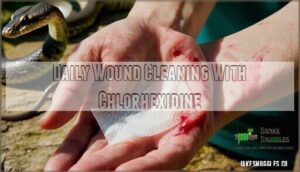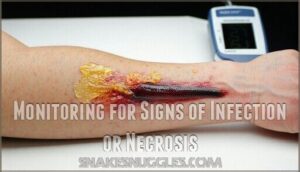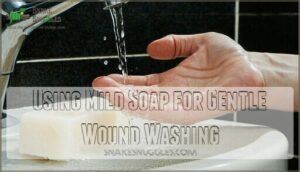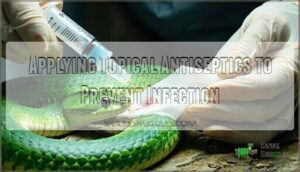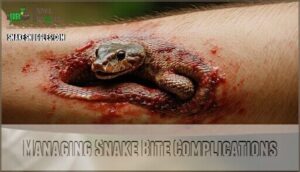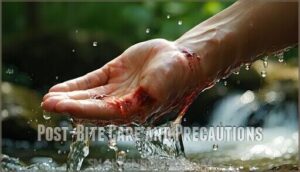This site is supported by our readers. We may earn a commission, at no cost to you, if you purchase through links.
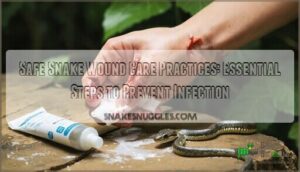
First, clean the bite area gently with soap and water, then apply antibiotic ointment and cover with a sterile bandage.
Don’t use tourniquets or try to suck out venom – these old-school methods can make things worse.
Keep the wound elevated and watch for signs of infection like increased redness, swelling, or pus.
Most importantly, get to a hospital immediately for possible antivenom treatment.
The clock’s ticking when venom enters your system, and proper wound care combined with medical attention can mean the difference between a scary story and a medical emergency.
The importance of acting quickly and seeking immediate medical attention cannot be overstated.
Table Of Contents
- Key Takeaways
- Snake Bite Wound Care
- Reducing Infection Risk
- Safe Wound Treatment
- Managing Snake Bite Complications
- Post-Bite Care and Precautions
- Frequently Asked Questions (FAQs)
- How to care for a snake wound?
- What to put on snake wounds?
- What antiseptic is safe for snakes?
- How to help a wounded snake?
- How long should you wait before exercising after a snake bite?
- Can you shower or bathe with a snake bite wound?
- Should you take pain medication for snake bite discomfort?
- When is it safe to return to work after treatment?
- Conclusion
Key Takeaways
- Clean and protect the wound immediately – You’ll need to gently wash the bite area with soap and water, apply antibiotic ointment, and cover it with a sterile bandage to prevent infection.
- Avoid dangerous traditional remedies – Don’t use tourniquets or try to suck out venom, as these methods can worsen tissue damage and increase complications.
- Monitor for infection signs daily – Watch for increased redness, swelling, pus, or fever, which signal serious complications requiring immediate medical attention.
- Seek emergency medical care right away – You’ll need antivenom treatment within 4-6 hours for maximum effectiveness, making immediate hospital care essential for venomous snake bites.
Snake Bite Wound Care
When a snake bites you, immediate wound care can prevent serious infection and complications.
Proper cleaning and protection steps reduce your risk of developing the dangerous infections that affect nearly one-third of all snake bite victims, which can lead to serious health issues, and thus, proper care is essential to prevent complications.
Cleaning The Wound With Soap and Water
After a snake bite, you’ll need to start wound care immediately. Begin by washing the bite area with mild soap and clean water using gentle motions.
Start wound care immediately after a snake bite—clean gently with mild soap and water.
Avoid forceful irrigation that can push bacteria deeper into the wound. Use lukewarm water temperature for comfort and effectiveness.
Pat the area dry with a clean towel using gentle drying techniques. This snake bite first aid step is vital for wound infection prevention and proper wound treatment.
It’s important to use sterile saline or mild antiseptic solutions for effective wound cleaning.
Applying Antibiotic Ointment to Prevent Infection
After cleaning the wound, you’ll want to apply a thin layer of over-the-counter antibiotic ointment to create a protective barrier against infection-causing bacteria.
Popular brands work similarly, but watch for allergic reaction signs like increased redness or swelling. Many people find suitable antibiotic ointments readily available.
Apply the ointment once or twice daily to prevent snake bite infection without overuse, which can lead to antibiotic resistance risks.
Covering The Wound With a Clean Dressing
After applying antibiotic ointment, you’ll need proper wound protection to maintain healing.
Cover the bite with sterile gauze or adhesive bandages using clean hands for sterile technique.
Change the wound dressing daily or when it becomes wet or dirty.
This bandage application creates a barrier against dirt and bacteria while allowing air circulation.
Proper care requires using appropriate wound coverings.
Following these wound care guidelines helps prevent complications and supports recovery.
Reducing Infection Risk
After snake bites, proper wound care prevents serious infections that occur in about 31% of cases.
You’ll need to clean the wound daily and watch for warning signs like swelling, redness, or tissue death.
Daily Wound Cleaning With Chlorhexidine
When dealing with snake bite wounds, you’ll want to clean the area daily with dilute chlorhexidine solution.
This antiseptic outperforms soap and other alternatives in reducing bacterial colonization. Use a 0.05% chlorhexidine dilution for safe, effective wound cleaning.
Apply it gently once daily following proper wound care guidelines to prevent infection without delaying healing.
However, it’s worth noting that chlorhexidine can be cytotoxic to human dermal fibroblasts at certain concentrations.
Avoiding Forceful Irrigation of The Wound
While daily cleaning keeps wounds healthy, you must avoid forceful irrigation to prevent pushing bacteria deeper into tissues.
High-pressure washing can worsen bacterial spread and cause additional tissue damage, making infection more likely.
Follow these gentle wound care techniques:
- Use low-pressure water – Let water flow gently over the wound rather than spraying directly
- Apply soft dabbing motions – Pat the area clean instead of scrubbing or rubbing
- Choose alternative cleansing methods – Use saline solution or diluted antiseptic for safer cleaning
- Avoid aggressive flushing – Never use syringes or high-pressure devices on snake bite wounds
Gentle washing protects damaged tissues while still removing contaminants effectively.
Monitoring for Signs of Infection or Necrosis
Watch your wound daily for infection early signs like increased redness, warmth, or pus.
Watch for redness, warmth, or pus daily – these are your first warning signs of infection.
Temperature monitoring helps detect fever, while pain assessment tracks worsening discomfort.
Snake bite necrosis appears as darkening tissue around the bite.
Wound observation should include checking for spreading red streaks or unusual odors that signal serious wound infection requiring immediate medical care.
Maintaining proper humidity is key to preventing skin issues, which helps in preventing skin issues and reducing the risk of serious wound infection.
Safe Wound Treatment
When you’re treating a snake bite wound, you need to use the right methods to prevent infection and avoid making things worse.
Skip the old-fashioned remedies like suction or tourniquets—they don’t work and can actually harm you more.
Using Mild Soap for Gentle Wound Washing
Clean snake bite wounds gently with mild soap and lukewarm water to prevent infection. Use proper washing technique to avoid pushing bacteria deeper into the tissue.
- Soap Types: Choose antibacterial or plain mild soap without harsh chemicals or fragrances
- Water Temperature: Use lukewarm water that’s comfortable to touch, not hot or cold
- Washing Technique: Gently rinse around the wound without scrubbing or applying pressure
- Drying Methods: Pat dry with clean towel or gauze, don’t rub the wound area
- Soap Alternatives: Consider saline solution if soap isn’t available for snake bite wound cleaning
Applying Topical Antiseptics to Prevent Infection
Antiseptic effectiveness varies among products, so choose proven options like dilute chlorhexidine or iodine for snake wound care.
Apply these safe antiseptics gently using clean cotton or gauze, avoiding harsh scrubbing that damages tissue.
Proper application methods reduce infection risk while preventing antiseptic resistance.
Monitor for allergic reactions during wound treatment for snake bites.
Avoiding Traditional Remedies Like Suction or Tourniquets
You shouldn’t use suction or tourniquets for snake bite wound care despite their historical popularity.
Suction devices remove less than 2% of venom and can increase tissue damage. Tourniquets concentrate venom in the affected limb, raising amputation risk.
These traditional remedies delay proper medical intervention and worsen bite complications. Focus on wound cleaning protocols instead.
Experts advise against tourniquets because they can lead to permanent limb disfigurement.
Managing Snake Bite Complications
Snake bite complications can cause serious tissue damage and life-threatening infections if not properly managed.
You need to recognize warning signs early and take immediate action to prevent severe outcomes like necrosis or amputation.
Recognizing Local Tissue Injury and Necrosis
Local tissue injury develops rapidly after venomous snake bites, with swelling and pain appearing within 30-60 minutes.
Watch for blackened skin, blistering, and fluid oozing from puncture wounds – these indicate necrosis identification challenges ahead.
Bite severity increases with delayed treatment, raising amputation risk substantially, and early tissue damage recognition helps prevent long-term effects through proper snake bite wound care protocols and wound management strategies.
Immediate action requires calling 911 promptly for medical assistance.
Understanding The Importance of Prompt Medical Attention
Time matters when snake bites occur.
Quick medical attention prevents tissue damage from spreading and reduces infection risk.
Medical expertise guarantees proper wound treatment protocols are followed.
Snake bite medical attention becomes a medical emergency requiring immediate care.
Delaying treatment allows long-term effects to develop.
Antivenom urgency increases with every passing hour after the bite occurs, and this situation demands immediate care.
Administering Antivenom to Minimize Severe Outcomes
When you’re facing a venomous snake bite, antivenom administration becomes your lifeline.
You’ll need this snake bite antivenom within 4-6 hours for maximum antivenom effectiveness.
Healthcare providers typically give 4-6 vials intravenously, adjusting dosage timing based on severity.
Watch for allergic reactions like rash or breathing problems during treatment.
Post-administration care includes monitoring for complications and following snakebite management protocols your medical team establishes.
Post-Bite Care and Precautions
After treating a snake bite wound, you’ll need to monitor it closely for signs of infection and complications.
Keep the wound clean and dry while watching for symptoms that require immediate medical attention.
Watching for Infection Symptoms After a Snake Bite
Watch for snake bite wound infection signs within 24-48 hours after the bite.
Swelling signs include increased redness, warmth, and expanding inflammation beyond the initial wound area.
Pus indicators like yellow or green discharge signal bacterial infection.
Systemic symptoms such as fever above 100°F, chills, and red streaks spreading from the bite require immediate medical attention for proper wound care.
Keeping The Wound Clean and Dry to Promote Healing
Daily wound care for snake bites requires proper dressing choices and moisture control to create an ideal wound environment.
Change bandages regularly to prevent bacteria buildup while maintaining appropriate moisture levels.
Clean dressings protect against contaminants and support the natural healing timeline.
Monitor the wound management process closely, as infection prevention depends on consistent wound care for snake bites and proper wound cleaning techniques.
Seeking Medical Help for Severe or Worsening Symptoms
Call emergency services immediately if you notice escalating pain, spreading redness beyond the bite site, or systemic symptoms like difficulty breathing.
Don’t wait if you experience loss of function in the affected limb. Delayed treatment can worsen snake bite complications substantially.
Snake bite first aid includes immobilizing the affected area. Emergency medical services can provide antivenom and proper care for serious bite complications requiring immediate medical attention.
Frequently Asked Questions (FAQs)
How to care for a snake wound?
A snake bite wounds can become your worst nightmare if bacteria invade the damaged tissue.
Clean the wound immediately with soap and water, then apply antibiotic ointment and cover with a clean bandage.
Seek medical attention quickly.
What to put on snake wounds?
Clean the wound with soap and water, then apply antibiotic ointment and cover with a clean bandage. Seek immediate medical attention for proper treatment and potential antivenom.
What antiseptic is safe for snakes?
About 8% of snake bite victims develop infections, making proper antiseptic choice essential.
You’ll want to use dilute chlorhexidine or iodine solutions for daily cleaning.
These gentle antiseptics effectively kill bacteria without damaging healing tissue like harsher chemicals might, which is crucial for proper healing.
How to help a wounded snake?
Gently restrain the injured snake using a towel or cloth to prevent further harm. Clean minor wounds with dilute antiseptic solution, then contact a veterinarian immediately for proper treatment.
How long should you wait before exercising after a snake bite?
Wait at least 48-72 hours before exercising after a snake bite.
Your body needs time to heal and process any venom.
Start with light activity and gradually increase intensity based on how you’re feeling.
Can you shower or bathe with a snake bite wound?
Water exposure can be absolutely catastrophic for healing wounds.
You shouldn’t shower or bathe with an open snake bite wound until it’s properly closed and healed.
Keep the wound dry and covered with waterproof dressing if you must bathe nearby areas.
Should you take pain medication for snake bite discomfort?
Take over-the-counter pain relievers like ibuprofen or acetaminophen for snake bite discomfort, but avoid aspirin since it can increase bleeding risk and complicate treatment.
When is it safe to return to work after treatment?
Return to work depends on your recovery progress and job demands.
Most people can resume desk work within 2-3 days if the wound’s healing well and you’re not experiencing severe pain or complications.
Conclusion
Smart snake bite care starts with staying calm and following safe snake wound care practices.
Clean the bite gently with soap and water, apply antibiotic ointment, and cover with sterile bandaging.
Don’t attempt dangerous methods like suction or tourniquets.
Monitor for infection signs including redness, swelling, or discharge, and keep the wound elevated.
Seek immediate medical attention for antivenom treatment, as proper wound care combined with professional medical intervention provides your best defense against complications and guarantees the best healing outcomes.
- https://my.clevelandclinic.org/health/diseases/15647-snake-bites
- https://www.cdc.gov/niosh/outdoor-workers/about/venomous-snakes.html
- https://www.who.int/teams/control-of-neglected-tropical-diseases/snakebite-envenoming/treatment
- https://www.mayoclinic.org/first-aid/first-aid-snake-bites/basics/art-20056681
- https://mdpremier.com/first-aid-snake-bites/

